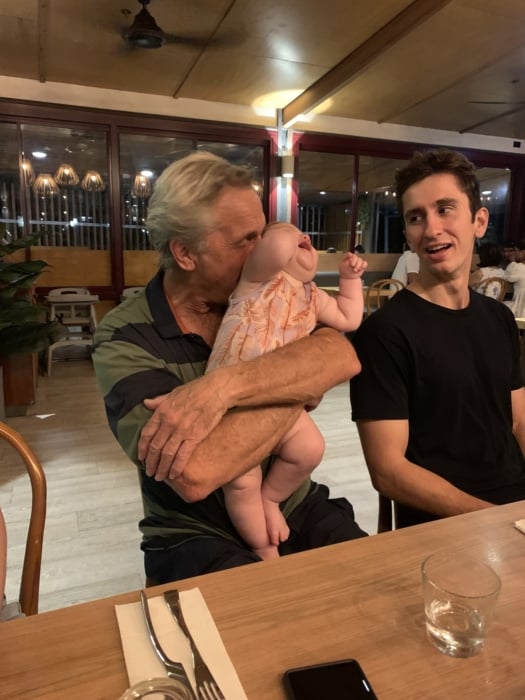This month’s training report will cover:
Last month, I had a week-long trip to my favorite holiday location, Kingfisher Bay at Fraser Island. I have been going here almost every year since I was a child. My parents first took me when I was 10 months old (same as Elora on this trip).
Fishing is the main priority here. There’s a long jetty that pushes into the channel. Some big fish have been caught here over the years. Mackerel, tuna, jewfish, sharks. It’s a great experience in case you ever visit Australia. Just let me know before you come and I can give you a few tips.
You might recognize Kingfisher Bay from my paintings over the years. It has been one of my go-to subjects. That’s partly because it’s a beautiful place and partly because it’s sentimental and meaningful to me. I enjoy painting sentimental subjects. It puts more energy behind the work.
Here’s a painting based on the most recent trip:

And here's the reference photo:

You can download the full-resolution photo here. This was taken around sunset from the end of the jetty. The contrast was sharp and the sky was full of color and life.
A few notes on this painting:
- I started with a monochrome foundation. See the progress shot below. Then, I applied the rich colors over the top. I didn't wait for the underpainting to dry before painting over the top. Rather, I worked the other colors into the underpainting, or I used a loaded brush to apply thick, undiluted color over the top. For this to work, you need to use good paints and good brushes. Otherwise, you'll struggle to make clean strokes without the colors mixing.

- I painted it in a single session, wet-on-wet. In an ideal world, I would complete every painting in a single session. I find it produces paintings that are more fresh and lively and consistent in technique. If painting over several sessions, you need to get yourself back into the right mindset at the start of each session. You'll also need to deal with the paint drying between sessions.
- My painting is generally lighter than the reference photo. That's because the reference photo is underexposed in the darks and doesn't capture the brilliance of the sky. Cameras are helpful, but they are no match for what our eyes can do!
- Broken color was particularly effective for capturing the shimmering light on the water.
I also painted this particular scene back in 2020. See below. I used a different approach for this painting, relying on both palette knives and brushes. And it shows. The subject may be roughly the same, but the two paintings are completely different.

Below are some other photos from the trip. Though not related to painting, I figure you might like to see how fast Elora is growing up.
The only time I don’t actively think about painting or writing about painting is when I’m fishing.
When I’m not fishing, I find it hard to switch off my painting brain. I can’t help but see everything as a potential subject, or ponder over a strategy for the next painting, or scrutinize my last. This is fine until it’s not. Always being switched on leaves me vulnerable to burnout. And it doesn’t matter how productive I am in the short term if I end up with a nasty case of burnout that could put me out for weeks, even months.
So, I make a conscious effort to do a spot of fishing every few weeks and to go on a dedicated fishing trip at least once a year. This gives my painting brain a chance to relax and reset.
My question to you: What is your “fishing” activity? Are you doing it enough?
I think you'll find it to be more productive in the long term if you prioritize time away from painting. Time away is important. It may not feel productive, but it is important.
I have picked up on my running lately. I have a love-hate relationship with running. I love the struggle and challenge of it. I hate the rest of it.
I wasn’t built to be a runner. My brother was. He struggles to put on weight and is built for endurance. I, however, was born with a particular appreciation of food and a body that works better in short bursts. But this is exactly why I keep running. It keeps me humble and familiar with the beginner's mindset.
The beginner’s mindset is particularly important. There’s nothing more hungry, curious, and driven than a motivated beginner. The challenge is holding onto that mindset as you improve. It’s easy to get complacent when things start to click. But as soon as you get complacent, you’ll begin to stagnate.
Doing things you find hard and are out of your comfort zone will keep your ego in check and your beginner's mindset sharp. There's some good discussion on this in The Art of Learning by Josh Waitzkin. Well worth a read. Waitzkin is a chess prodigy, BJJ blackbelt under Marcelo Garcia, and Taiji world champion. He doesn't paint, but the lessons in his book can be applied to painting.
I recently sent an email to newsletter subscribers with an updated list containing some of history’s greatest landscape painters. In response, we were flooded with the names of artists to add to the list. Artists like Ivan Fedorovich Choultsé and Arkhyp Kuindzhi who were new to me. (Look at those colors!)
To add to this, you should also check out the following contemporary landscape painters:
- Aaron Cordell Johnson
- Abiodun Olaku
- Alberto Valentini
- Alexander Babich
- Alexey Savchenko
- Alice Boggis-Rolfe
- Allie Zeyer
- Andrew Gifford
- Anne Rose Bain
- Bato Dugarzhapov
- Bhavani Krishnan
- Bob Stuth Wade
- Brent Cotton
- Brian Blood
- Camille Przewodek
- Carol Jenkins
- Charity Anderson
- Charles Muench
- Chirun Ilya
- Chris Easley
- Clyde Aspevig
- Dan Knepper
- Dan Schultz
- Daniil Volkov
- David Ballew
- David Griffin
- Deborah Paris
- Denis Gubarev
- Denys Gorodnychyi
- Devin Roberts
- Dmitriy Permiakov
- Donna Lewinter
- Dottie Leatherwood
- Doug Fryer
- Ellie Wilson
- Erin Hanson
- Frank Gardner
- Frank Serrano
- Hannah Heyer
- Hillary Scott
- Ignat Ignatov
- Jake Gaedtke
- Jane Hunt
- Jeff Cochran
- Jenny Aitken
- Jim McVicker
- Jivan Lee
- Jove Wang
- Julie Davis
- Kami Mendlik
- Kathleen Hudson
- Kim Casebeer
- Lena Rivo
- Leon Holmes
- Linda Gooch
- Malanie Thompson
- Marc Hanson
- Mark Boedges
- Mary Pettis
- Mason Archie
- Matt Smith
- Mekhova Evgenia
- Mikel Wintermantel
- Paul Batch
- Paul Fowler
- Pavel Shumov
- Peter Holbrook
- Ralph Oberg
- Renan Ozturk
- Rich Bowman
- Rita DiCaprio
- Robert Wellings
- Russell Chatham
- Scott Christensen
- Slava Korolenkov
- Stanislav Brusilov
- Stephanie Marzella
- Sue Goddard
- T. Alan Lawson
- Thomas Kegler
- Tiffanie Mang
- TJ Cunningham
- Udelov Andrey
- Vilkov Andrej
It blows my mind how many remarkable painters there are in the world. Many of them fly under the radar. Whenever you are lacking inspiration, explore the artists on this list and that will surely get the creative juices flowing.
If your favorite contemporary landscape painter is missing from the list, let me know in the comment section at the bottom.
Below is what I’m painting next. The photo depicts Brisbane city on a foggy morning. The sunlight was diffused by the clouds and fog and everything was bathed in a white glow. This scene in particular struck me with the sharp contrast between light and shadow, the shimmering greens, and the red and orange flowers scattered over the ground. I was out running at the time, but I had to stop for a photo as it was one of those “I need to paint that” moments.

You can download the full-resolution photo here.
I’ll share how it turns out in the next report (fingers crossed it turns out ok…).
The big ideas of this painting will be:
- The glimmering light on the grass.
- The value contrast between the bright background and the dark tree and its cast shadow.
- The red and orange flowers scattered across the ground. There could draw inspiration from Claude Monet’s paintings of poppies.
The challenges will be:
- Capturing the illusion of light.
- Painting the distant buildings with enough detail to convey meaning, but not so much that they look over rendered and out of place.
- Capturing the complex forms and shapes of the tree.
My strategy will be:
- I’ll use brushes and broken color, drawing inspiration from artists like Bato Dugarzhapov, Slava Korolenkov, and Chirun Ilya.
- I’ll err on the side of having too much value contrast and too rich reds and oranges for the flowers.
I’m sharing this with you now as it gives you a chance to see my thought process before I have picked up a brush.
Feel free to paint from the reference photo yourself. It would be interesting to see different interpretations of the same subject. Share the outcome with us at admin@drawpaintacademy.com before the next report comes out. I did this once before with my Minnippi painting and it was great to see all the different paintings that were submitted.
That's the great thing about art—we can all look at the same subject and come up with completely different paintings. Our perception of the world is not fixed from person to person. It's wildly unique and we can use art to showcase this.
Until next time, happy painting!
Dan Scott
drawpaintacademy.com














Thanks, Dan. This is so helpful. MY “fishing’ activity is walking-mainly along the Cornish coastal path. On the steep climbs and plunging downs you have to concentrate on your feet but along the high flat part you can think about distant light and colour before stumbling on a puff ball mushroom or a cobweb spider. This is the place where I can reflect, ruminate and plan. Gotta go NOW!
Than you for the question :”What is your “fishing” activity? Are you doing it enough?”
Good to think about it.
For years, when I was working as an engineering specialist, my “fishing activity” was painting. Now I am retired and I have no main subject on my mind. I divide my time between painting, studying Greek as a foreign language, sport( yoga, Pilates, swimming) and cooking for family and friends. I love painting, it makes me happy ( you always say “happy painting”) but I cannot define myself as a full time artist, more an amateur. I cannot say if painting or Greek takes off more of my mind, but the balance works.